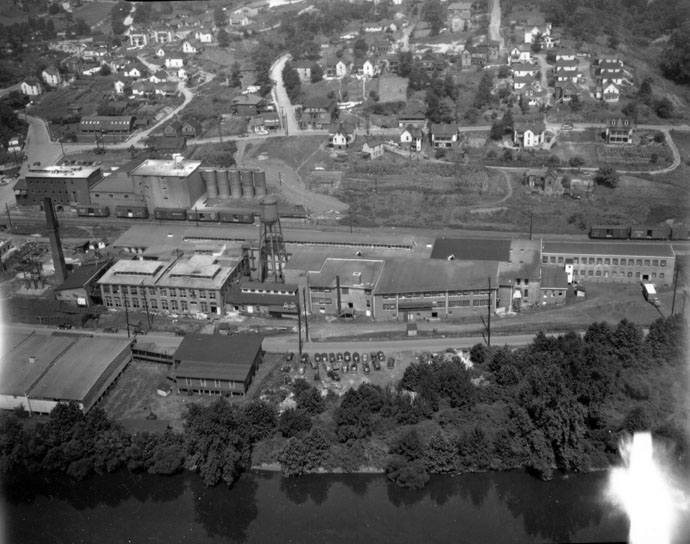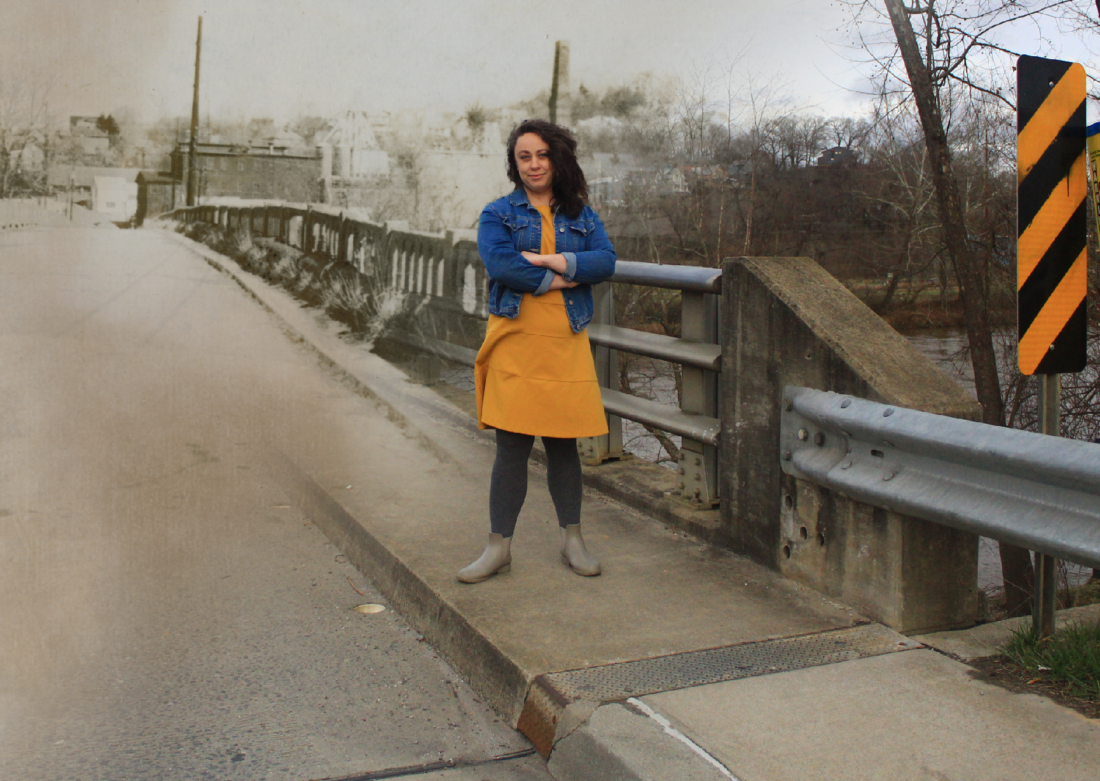Like so many others at the beginning of the COVID-19 pandemic, Katherine Cutshall needed something to occupy her time while quarantining at home. Perhaps not surprisingly, Cutshall — the collections manager at Buncombe County Special Collections — began going through her family records and heirlooms, which her father had gathered over the previous decades. Her ties to the area, Cutshall notes, date to the 18th century.
“It’s probably why I became an archivist,” says Cutshall, who, along with her work with the county, serves as a member of the N.C. State Historical Records Advisory Board and was appointed to the Vance Monument Task Force in 2020. “I grew up with this basement of stuff, and it’s all so cool.”
While going through the boxes, Cutshall was surprised to discover information about the extralegal activities of a distant relative in the first half of the 20th century. More broadly, the documents also revealed a larger story about Asheville’s West End-Factory Hill neighborhood located near the River Arts District in the area known today as Chicken Hill.
On Thursday, March 24, 6-7 p.m., Western North Carolina Historical Association will host Cutshall for a live Zoom talk about her research, West End Women: Liquor, Labor and Love in New Deal Urban Appalachia.
Dusty and dirty
Obituaries and wedding announcements made up the bulk of Cutshall’s early family findings. But amid these everyday documents, the archivist also discovered an interesting police record concerning Grace McAbee, her paternal grandmother’s aunt. According to Cutshall, McAbee was around 15 years old when she and her father were arrested for chicken theft.
“It led me down a rabbit hole,” remembers the archivist. “I started thinking, ‘OK, what else is happening here?’”
More notices about McAbee emerged — from police raids on her home and business to multiple family members arrested for bootlegging.
The story, Cutshall continues, “just kept building.”
As did the archivist’s research into the Asheville neighborhood McAbee ultimately called home, after being born into poverty in Haywood County at the start of the 20th century.
In Cutshall’s invitation to her upcoming talk, she notes, “The West End-Factory Hill neighborhood was characterized by poor white families who worked as industrial laborers along the French Broad River.” The C.E. Graham Manufacturing Co., a cotton mill, opened in the 1880s and became a major employer in the area. A village of small homes for its millworkers was later constructed on Factory Hill.
In 1894, Moses and Caesar Cone purchased the mill and expanded the operation, hiring additional employees and adding more one-bedroom cottages to Asheville’s West End neighborhood. At its peak, the mill employed roughly 300 people.
But by the 1930s, workers endured layoffs and economic hardships brought on by the Great Depression.

“Following the Second World War, after years of limited investment, the mill owners began divesting themselves of their holdings on Chicken Hill,” notes the website, ChickenHillnc.com. “Starting in 1949, with the struggle to compete with overseas markets, the mill began selling houses to the factory workers, taking out a small sum from their paychecks. This continued until 1953 when Caesar Cone finally shut down the mill, leaving the new homeowners unemployed.”
For the next half-century, Chicken Hill suffered decline as the community disbanded and unemployed workers sought jobs elsewhere. Some houses collapsed, and others were used by the Asheville Fire Department for burn practice.
“This was a loud neighborhood. It was a smoggy neighborhood. It was dusty and dirty and muddy,” Cutshall says of the tangle of streets where her relative lived, worked and ran illegal booze. “This wasn’t the glamorous Haywood Street of the 1920s.”
Shadow economy
Asheville’s history tends to focus on flashy moments and luminous people — Thomas Wolfe, Douglas Ellington, E.W. Grove and other powerful white men who appeared to run the city. But there were forces at work behind the scenes, too, says Cutshall.
“I love the term ‘shadow economy,’” the archivist notes, referring to bootlegging, prostitution and petty theft. “That’s what it is [because] if you suspended those businesses, it affects the overall economy. Just because it’s not legitimate doesn’t mean it’s not happening.”
In her talk, Cutshall will also touch on redlining, the discriminatory practice which withheld services from neighborhoods deemed too hazardous to invest in. Oftentimes — as in Asheville’s East End, Stumptown and Southside neighborhoods — such homes were razed to make way for crosstown expressways, which further isolated residents.
“Grace’s immediate neighborhood was sandwiched between three redlined neighborhoods,” Cutshall explains. Redlining disproportionately affected communities of color, but one of the communities bordering McAbee’s home was almost entirely white. City officials, says Cutshall, claimed the zoning was because “a low class” of people had moved in.
“As I’ve gone back and reconstructed the neighborhood in my mind’s eye, [redlining] was very destructive,” Cutshall says. “It transformed the area from an industrial neighborhood to an industrial zone.”
The archivist’s research also turned up information about the formation of the federal women’s prison system. Among her periods of incarceration, McAbee was sentenced to a term of hard labor on the roads. She also served time at Federal Prison Camp, Alderson — where Martha Stewart was incarcerated in 2004. When Stewart was there, the minimum-security center was dubbed “Camp Cupcake.”
“But it was originally an experiment in women’s incarceration and reform,” Cutshall explains. Prior to its establishment, women were sent to the same federal prisons as men. “Alderson was built because there was an influx of female offenders in and around Prohibition.”
Though details about McAbee’s legal troubles remain vague, Cutshall was able to secure a copy of the warrant for her arrest. McAbee’s sentence, notes Cutshall, “was something like four years [but] the charge was only for 1 ½ pints of untaxed alcohol.”
Cutshall’s history talk may raise more questions than it answers. But it also paints a picture of a place and the people who lived there. It’s about a sector of Asheville almost lost to time, gentrification and development. And it’s a taste of what other stories might be lurking in basements and attics, just waiting for discovery.
WHAT: West End Women: Liquor, Labor and Love in New Deal Urban Appalachia
WHERE: History talk on Zoom. avl.mx/bce
WHEN: Thursday, March 24, 6-7 p.m. $5 WNCHA members / $10 general admission






Great story… thanks for sharing it. Oh, the old South… including Asheville… a wondrous but hard place… not easily or readily fathomed the further we are removed from it. Thanks again.
Excellent story.
The present day Craven St. Bridge that Ms. Cutshall is standing on was known as the Smith Bridge in 2 of its previous iterations – the 2nd Smith Bridge is what is showing in the background. The first one was a metal truss bridge that was destroyed in the 1916 flood. It was replaced by the concrete arched bridge in the pic behind Ms. Cutshall, and it was condemned and closed to traffic in the early 1980’s. Until the current structure was completed, you had to access Craven St. from Haywood Road by the Burger Bar at the end of W. Asheville Bridge, come down thru West Asheville via Waynesville Avenue, or come around from Emma on Emma Road.
And yes, Chicken hill and that whole industrial/railroad/stockyard district was a tough place – especially during its decline in the 1970’s-1990’s. As a lot of the old businesses closed and industrial properties were abandoned, working families moved out.
One building in the area that always fascinated me was the present day Hanger Hall school, which was originally a private home built by a mill owner and later owned by an older lady who kept a museum of sorts there! It was converted to a girl’s school I believe in the 70’s. There is a piece of Asheville’s architectural history sitting at the edge of the Hanger Hall lawn right by the street – one of the ornate capitals from one of the columns of the old Buncombe County courthouse – it is known as “The Ali Baba Urn” – although it is not an urn at all!